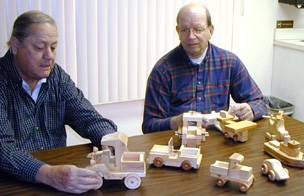
When Bill Johnson and a group of retired woodworkers in Florida got serious about making toys for local charities, they turned to the principles of mass production.
It all started seven years ago, when the retired middle school shop teacher from Long Island and his wife, moved into the Timber Oaks Retirement Community in Port Richey, Florida. With his background, Bill gravitated to a group of men in the community who made toys for local charities. After about six months, as older members started moving into nursing homes, the group began to wind down. And Bill decided it was time to make a few changes to increase the group’s output of toys.
“People don’t think about applying mass production to toymaking,” he explained. “But I had taught the basic ideas to my woodshop students back in Long Island and had the principles in my head. It dawned on me…we could maintain and even improve the quality by using the factory system.”
Based in Bill’s garage shop, the group talked to charities to identify the right kind of toys. They decided to make the 2×4 their basic raw material. In adapting plans from books and websites, they carefully considered size, weight, and design.
“I think a lot of designs are too heavy for kids to hold in their hands,” Bill noted.
When making a prototype, they sometimes change the design after discovering the cut of a piece is too hard to handle. Or that a certain order of cutting increases safety and accuracy. With one design, they found that in reducing a piece by a quarter of an inch they could split a 2×4 in half and eliminate waste. Since toys have to survive normal wear and tear, any weakness is quickly discovered using the “drop test”. Jigs and fixtures are created when needed, and every step goes into a binder.
“We keep a good record of everything.” Bill noted “Otherwise we might forget a step and end up with a cut that couldn’t be done and have to dump a whole bunch of wood.”
Once they are ready to start, they set up bins for stacking parts and moving them from process to process. When things get rolling, any stumbling blocks are soon detected and the process adjusted.
Even though it was his idea, the results still surprised Bill. “Suddenly we’d have 50 trucks done and it took so much less time,” he recalled.
Interchangeable parts are a necessity. Certain pieces have to be exact, while others can be off a bit, but whatever piece was in the bin had to fit. And they always make extras.
“There’s a certain amount of waste in the making extras,” Bill admitted, “But if we find a bad one, we don’t have to gear back up to make a single part. We always laugh when we find one and kid around about who made it.”
Laughter and fun are just as important as efficiency. The sense of camaraderie is a carryover from the original group. And as the de facto leader Bill doesn’t mind getting a little needling – he calls it “male bonding – without the beer.”
Like Bill, most of the woodworkers have their own garage shops, but they will soon be moving into a new community woodworking shop. (And Bill will finally be able to put his car in the garage!) The core group of five retirees (plus five or six helpers) meets once a week to build trucks, cars, airplanes, helicopters, and boats. Some are just silhouettes with wheels attached and other are more complicated with fenders.
All gluing is surface-to-surface, using fast drying yellow glue. And the group prefers a natural finish to show off the beauty of the wood. To add different colors, Bill looks for interesting grains and uses end grains, whenever he can. Each toy is finished with a fast-drying non-toxic oil from CherryTree. Quality control comes naturally to the group. They all have children and grandchildren and they never think of it as making 50 toys, but as making one toy for one child.
“The process has been a stunning success,” related Bill, “Reports indicate the toys have been enthusiastically received by the children.”
That’s the important part! Toys have gone to various charities, county services, and ministries. The batch that recently went to a women’s shelter — where ownership of a toy at Christmas is so important – was particularly rewarding for the woodworkers.
Now in the process of setting up a second toy-making group, Bill believes his approach could be a model for others to adapt and even improve.
“A lot of people decided they were spending too much time on the golf course,” he noted, “particularly after the attack in September, and want to be more involved.”





